Let's face it, pests are the bane of any gardener's existence.Although pesticides can be helpful in managing garden pests, they also have a number of drawbacks including: potential toxicity to humans, pets and pollinators. In fact, millions of pollinators die each year due to pesticides and tainted Milkweed is a common factor in Monarch mortality. Which begs the question: How do you get rid of the bad bugs while sparing your beloved pollinators and other beneficial bugs? Although the best option is to avoid pesticides altogether, many gardeners can't imagine not using any pesticides at all. Therefore, this blog will discuss pesticides with the lowest toxicity to pollinators and tips for safely applying pesticides. *Here is a list of EPA’s reduced risk pesticides that pose less risk to human health and the environment than existing pesticides. First off, What is a pesticide?Pesticides are a broad category of substances that are meant to deter, kill or discourage various types of pests such as weeds, nematodes, plant pathogens or fungi. The term pesticide includes herbicides, insecticides, nematicides, fungicide and other pest deterrents. 10 Tips for Using Pesticides SafelyKnow what type of insects you are targeting.Do not treat flowering plants. Do not spray where pollinators such as butterflies, bees and moths are actively foraging.When possible, eliminate weeds by mowing or pulling.Choose short residual materials and low-hazard formulations if insecticides absolutely must be applied during the flowering period to save the crop. Apply insecticides when pollinators are no longer foraging such as in the evening or early morning.Adjust spray programs in relation to weather conditions. If it is windy, do not spray.Read the pesticide label.When possible, remove bugs by hand.Reduce pressure of spray nozzle to prevent pesticide drift.If you choose to use pesticides, consider these safer options.Keep in mind that no pesticides are completely safe to pollinators but if you follow these guidelines, you may be able to minimize your impact. This is a list of pesticides that are considered pollinator safe by the Michigan State University extension office. Insecticidal soapsInsecticidal soaps are most effective on soft-bodied insects such as aphids, adelgids, lace bugs, leafhoppers, mealybugs, thrips, sawfly larvae, spider mites and whiteflies. They are not effective on pests as a residue on the plant surface, and therefore are not toxic to pollinators after the spray dries. They can be safely used at any time to control pests on plants that are not attractive to pollinators, but on pollinator-attractive plants spray at dawn or dusk when pollinators are not present. Horticultural oilsLike insecticidal soap, horticultural oils work best when the spray comes in contact with the pest. Once the oil spray dries, it does not have much effect and becomes safe for pollinators and other beneficial insects. Horticultural oil can be safely used at any time to control pests on plants that are not attractive to pollinators, but on pollinator-attractive plants they should be sprayed at dawn or dusk when pollinators are not present. Bacillus thuringiensis (B.t.)While a B.t. strain works well for its target pest, it also breaks down quickly in sunlight, becoming ineffective after a few days. This makes B.t. very safe for pollinators, predatory insects and mammals. B.t. can be sprayed even when bees or butterflies are present. MetarhiziumThe fungus Metarhizium anisopliae is found naturally in soils and infects and kills insects. M. anisopliae does not detrimentally impact honey bees and is being studied as a bio-insecticide of varroa mites, a pest of honey bees. SpinosadSpinosad is highly toxic to bees. However, toxicity is greatly reduced once the product has dried on the foliage, within three hours to one day depending on the product. Therefore, avoid use if bees are active, and if applications are needed, apply in the evening when bees are not active and product has time to dry. This product suppresses a broad number of caterpillar species and should not be sprayed or allowed to drift in known habitats for threatened or endangered species of caterpillars and butterflies. PymetrozineAs a caution, apply pymetrozine in the evening, night or early morning when bees and butterflies are not visiting blooming plants. Since this product is selective for aphids and whiteflies, there should be no impact on other pollinators or natural enemies. AcequinocylAcequinocyl is considered nontoxic to bees and can be applied at any time. Since acequinocyl is selective for mites, other pollinators and natural enemies should not be affected. More ResourcesThe Xerxes Society. https://xerces.org/neonicotinoids-and-bees/
UMass Extension https://ag.umass.edu/fruit/ne-small-fruit-management-guide/appendices-resource-material-listings-conversion-tables-0 North American Pollinator Protection Campaign http://pollinator.org/assets/generalFiles/NAPPC.pesticide.broch.Consumer-FINAL-05-27-10_170527_155657.pdf Pesticide Environmental Stewardship. https://pesticidestewardship.org/ipm/ Michigan State University Extension, How to protect and increase pollinators in your landscape. http://msue.anr.msu.edu/resources/how_to_protect_and_increase_pollinators_in_your_landscape/how_to_control_invasive_pests_while_protecting_pollinators#subpage BeyondPesticides. https://www.beyondpesticides.org/assets/media/documents/pollinators/nolongeraBIGmystery.pdf
17 Comments
Many people have been asking, “What's wrong with my Monarch caterpillar/egg/chrysalis?” This is a list of the MOST common problems that the Monarch Rearer may encounter and how you can either avoid your Monarch from being infected or avoid the infection from spreading to your other caterpillars. Hopefully these tips and indicators can help you raise healthier Monarchs in the future! Warning: Some photos may seem graphic or unpleasant. UPDATE: Flea and tick treatment along with several cleaning products in your home can be deadly to Monarchs caterpillars.We recently received this tip from one of our readers. Any flea or tick prevention given to cats or dogs, both topically applied and orally administered, are toxic to Monarch larvae. Allowing your treated cat or dog to rub against your Monarch's cage can cause harm or death to the caterpillars inside. Petting your animal after treatment and then gathering milkweed leaves or touching anything in your Monarch's cage can harm your caterpillars. Also, be aware of any potentially toxic cleaning products you may be using around your caterpillar cage such as Febreeze, other air fresheners, carpet cleaners, Windex, or Lysol. Remember that these are very delicate creatures and even small doses of chemicals can be fatal. Prevention: Whenever interacting with your Monarch caterpillars make sure you washed your hands prior and/or wear gloves to be sure that your hands are free of any chemicals. Try to use natural cleaning products inside the room your caterpillars are living. Black DeathWhat is Black Death? As the name suggests, this is a fatal and very unpleasant ailment for the Monarch. Black Death is a general yet appropriate term used to describe the effects of two different infections. Pseudomonas is a bacteria that thrives in moist environments and Nuclear polyhedrosis virus (NPV) is a virus. How to tell if your Monarch has Black Death: Your caterpillar may be fine one day and the next start to become lethargic, start to deflate, refuse to eat and start to turn a darker color. Sometimes their chrysalises will turn dark brown or they pupate and then liquefy into a black goo. This can be a traumatic experience for the Monarch Rearer but once your caterpillar has contracted Black Death, it is nearly impossible to save them and the best thing to do is remove it immediately from the cage and disinfect anything it may have touched in order to prevent it from spreading to other caterpilalrs. Note: NPV causes the caterpillar to climb to a high spot, hang in an l or inverted V shape, and die. The caterpillar then liquefies inside and when the skin of the caterpillars splits open, the black goo will send millions of virus particles on its surroundings. The smell is very pungent. If a caterpillar lies at the bottom of a rearing container (instead of crawling higher in the container) and dies either firm or mushy, it is not infected with NPV. How to prevent Black Death
O.E. (Ophryocystis elektroscirrha)What is OE? OE is a protozoan parasite that is spread through microscopic spores coming off the wings and bodies of adult butterflies. These spores are packed in between scales on the Monarch's body and when it lays eggs, often attaches to the egg shell. Because OE is a parasite, it relies on a living host and will generally not kill Monarchs but will lead to weakness, disfigurement, and lethargy. Eventually it may die from sheer exhaustion. How to tell if your Monarch has OE: You won't be able to tell if a Monarch has OE until it's in the pupal or adult stage. Infected chrysalises won’t have a uniform green color. You can check your chrysalis closely to make sure it's dark spots are mirrored on both sides. Heavily infected Monarchs may not emerge or if they do they may be deformed or too weak to hold on. How to prevent OE:
Tachinid FliesWhat are Tachinid Flies? Tachinid flies can be difficult to differentiate from other flies in your garden. However, if you look closely, you will see that they are hairy and have huge red eyes. How tell if your Monarch was infected by a Tachinid Fly: This is one of the easiest Monarch infections to identify. They lay eggs on monarch caterpillars and once hatched, the maggots will bore into the caterpillar and feed on them while they are still living. You can generally tell if your caterpillar has been infected if it suddenly gets much skinnier and will sometimes die while attempting to form it’s chrysalis. These flies also lay eggs inside chrysalises. After it’s host has died, the maggots will emerge, leaving tell-tale white strands of silk hanging from the caterpillar or chrysalis. How to prevent Tachinid Flies:
Pesticide PoisoningSadly, it occurs quite often where nurseries treat their milkweed with pesticides or roadsides/fields are sprayed where you collected milkweed/caterpillars unknowingly. How to tell if your Monarch has come into contact with Tainted Milkweed: If your caterpillar has ingested pesticides it will often expel green vomit. How to avoid this from happening:
Trichogramma Wasps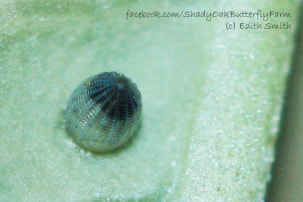 What are Trichogramma Wasps? They are tiny parasitic wasps that inject a single egg into the eggs of the pest. After consuming the contents of its host egg, a new adult wasp will emerge within 10 days. How to tell if your Monarch has come into contact with Trichogramma Wasps: If your egg turns completely dark keep an eye on it for the next couple of days to make sure a Monarch doesn’t hatch. If it doesn’t hatch, squeeze the egg inside of the leaf and dispose of the leaf. How to avoid:
Chalcid Wasps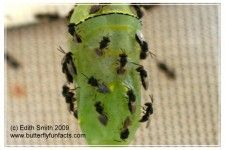 What are Chalcid Wasps? This is another tiny, parasitic wasp that waits for the perfect moment to attack your beloved caterpillar. It will approach when the caterpillar is in it’s vulnerable “J” stage and wait for it to form a chrysalis. Then, right afterwards, it lays hundreds of its eggs in the soft chrysalis. How to tell if your Monarch has been infected by Chalcid Wasps: Look for small black dots where it appears they have deposited their eggs. How to avoid:
Anal ProlapseWhen this occurs, the caterpillar’s rectum protrudes from its anus, leaving a bright green ball at the end of your caterpillar. It’s not known what causes this, but it’s always fatal to the caterpillar. Resourceshttps://monarchbutterflygarden.net/common-monarch-diseases-prevention/
http://butterflyfarms.org/monarch-predators-parasites-and-diseases/ https://monarchjointventure.org/resources/faq/common-monarch-problems https://butterfly-fun-facts.com/oe-ophryocystis-elektroscirrha-monarch-butterfly/ |
AuthorRebecca Chandler Archives
March 2024
Categories |

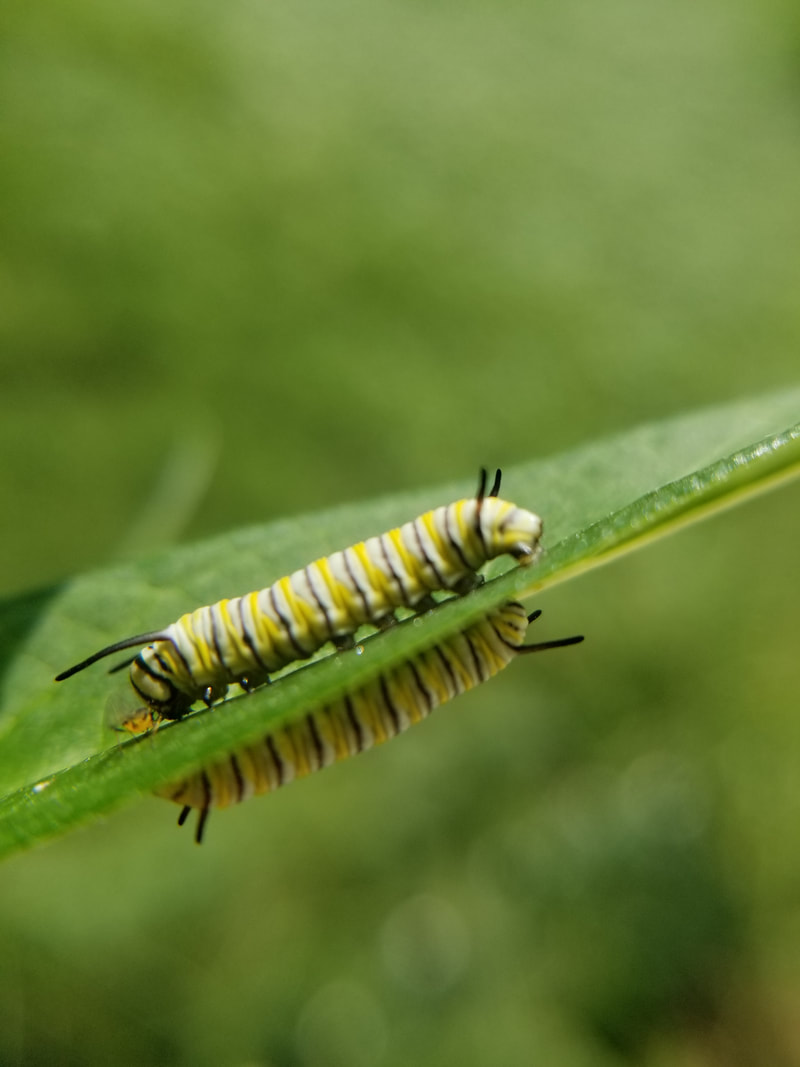
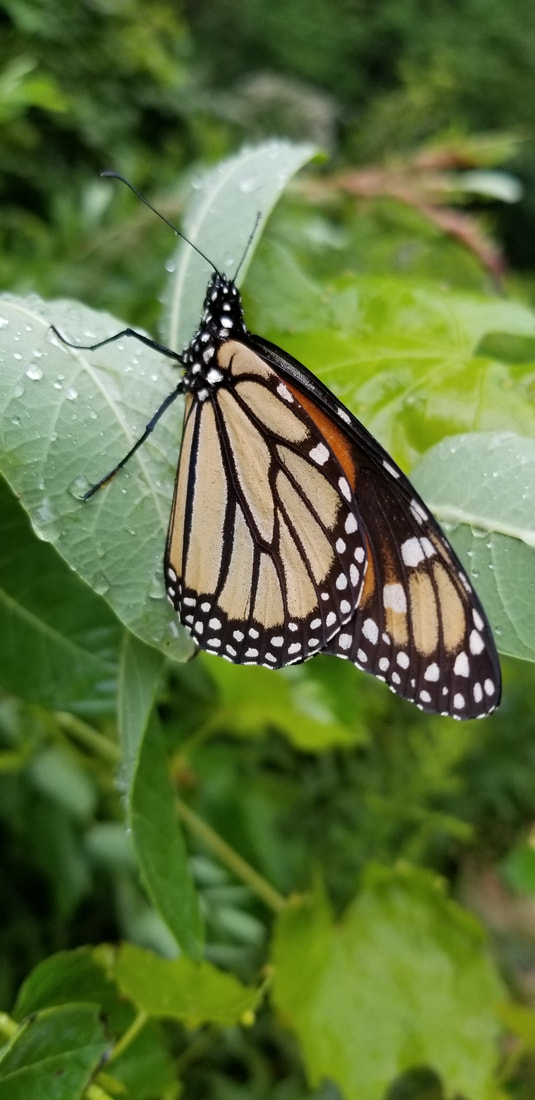
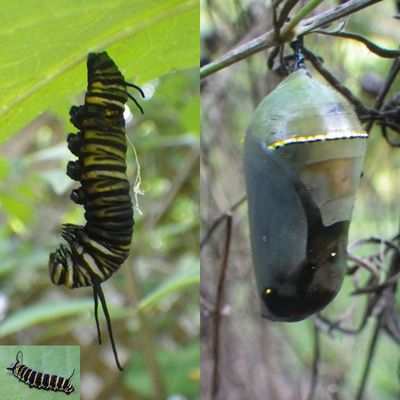
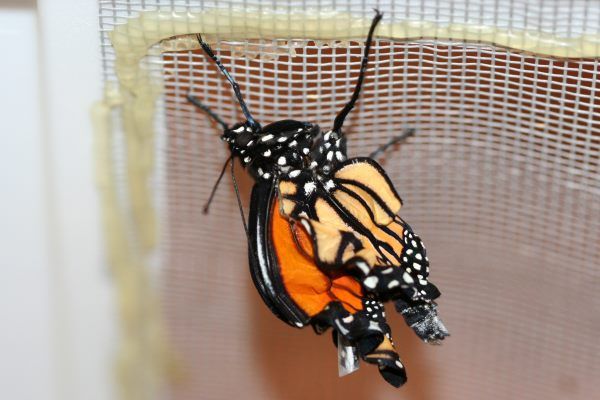
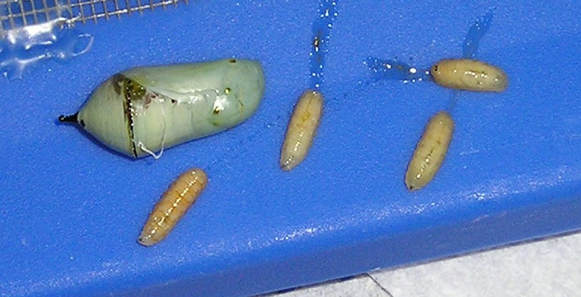
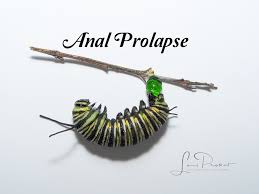

 RSS Feed
RSS Feed